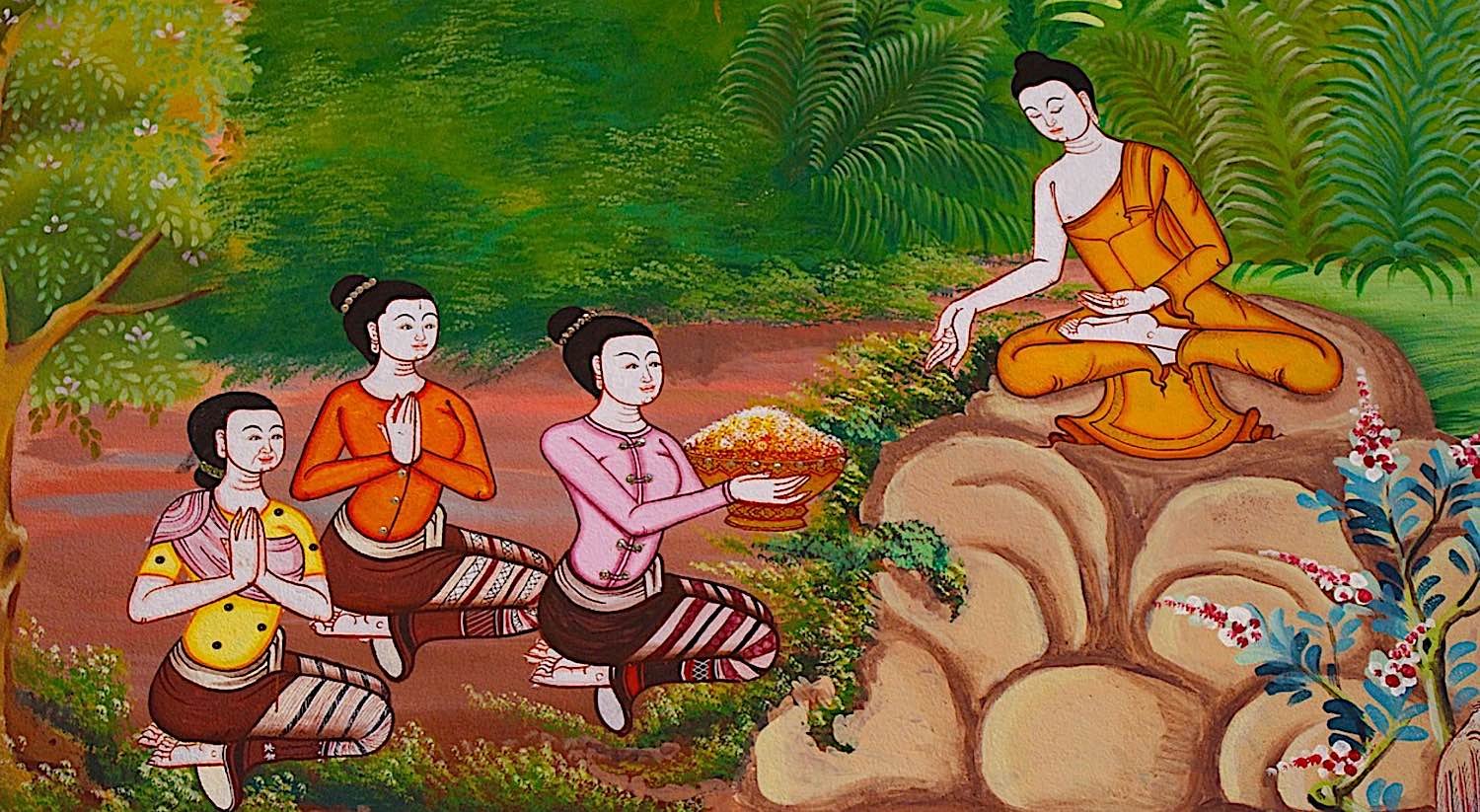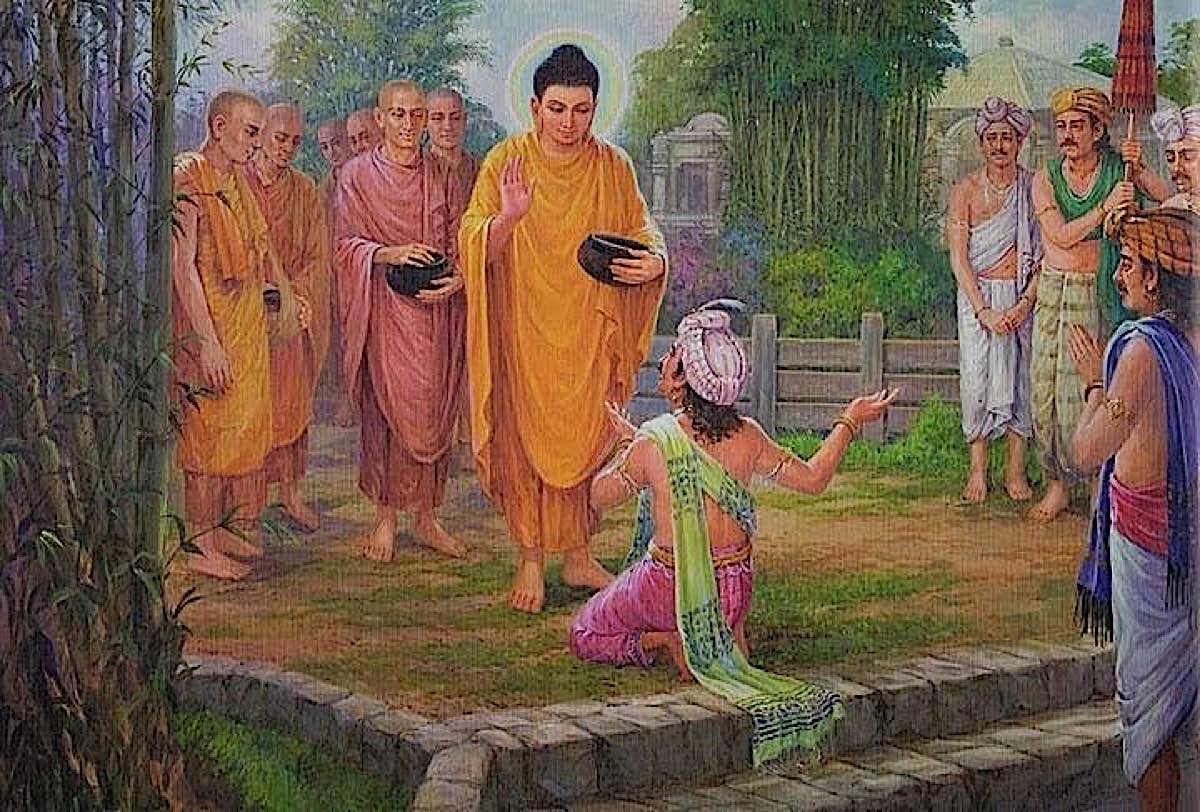Jambhala Prosperity Practice: Opening the Heart to Generosity Does it seem counterintuitive that one of the treasured Buddhist practices is focused on wealth generation? Considering the Buddhist teachings on renunciation, it may seem surprising that not only did Shakyamuni...
Jambhala Prosperity Practice: Opening the Heart to Generosity
Does it seem counterintuitive that one of the treasured Buddhist practices is focused on wealth generation? Considering the Buddhist teachings on renunciation, it may seem surprising that not only did Shakyamuni Buddha teach lay disciples about the wise handling of money, but he also offered “prosperity practices” such as Jambhala ( ?????? Dzambala, Zambhala). In the Vyagghapajja Sutta Buddha taught four methods for lay disciples:
“The accomplishment of persistent effort (utthana-sampada), the accomplishment of watchfulness (arakkha-sampada), good friendship (kalyanamittata) and balanced livelihood (sama-jivikata).”
 Yellow Jambhala
Yellow Jambhala
Note: Jambhala is the best transliteration of the Sanskrit, although often it is transliterated as Dzambala, Zambhala, or other variations. The Sanskrit seed letter, though is Ja and the proper transliteraiton would be Jambhala. Other forms of Jambhala, [Devanagari/Hindi] ??????, [Bengali] ??????, [Gujarati] ??????, [Kannada] ??????, [Malayalam] ??????, [Telugu] ??????
Buddha Weekly Documentary Video on Yellow Jambhala — INCLUDING How to do a WATER OFFERING:
Wealth is Not a Negative and has Positive Uses
Why? One of the methods of Buddhism is to release our attachments and cravings. How do these four teachings, especially sama jivikata, or “balanced livelihood”, and practicing for prosperity complement this teaching? ‘ In an earlier feature, we cited Buddha speaking in the Adiya Sutta:
‘My wealth has been enjoyed,
my dependents supported,
protected from calamities by me.
I have given supreme offerings
and performed the five oblations.
I have provided for the virtuous,
the restrained,
followers of the holy life.
For whatever aim a wise householder
would desire wealth,
that aim I have attained.
 Namtoshe Vaisravana emanation of the Jambhalas, mounted on a snow lion. Print available from Vajrayana Print on Etsy>>
Namtoshe Vaisravana emanation of the Jambhalas, mounted on a snow lion. Print available from Vajrayana Print on Etsy>>What is the purpose of Wealth?
Kyabje Garchen Rinpoche often teaches on Bodhichitta and an altruistic mind. In his wonderful book Vajrakilaya: A Complete Guide with Experiential Instructions, he wrote[1]:
“Whenever one has the intention to benefit others, one will naturally guard ethical discipline… Whenever altruistic mind is present, one will practice generosity, which becomes the cause of attaining wealth and resources. When one has the altruistic mind, one will spontaneously cultivate patience, which frees one from hunger, poverty, and the like. Thus, the first three perfections — generosity, ethical discipline, and patience — are the natural qualities of loving-kindness.”
 The Five Jambhalas as a Mandala with Namtoshe Vaisravana in the center surrounded by White (bottom center) Yellow, Red, Black and Green Jambhalas. On the top is Vajrapani and above him the Buddha of the Jambhalas Ratnasambhava. Print available from Vajrayana Print on Etsy>>
The Five Jambhalas as a Mandala with Namtoshe Vaisravana in the center surrounded by White (bottom center) Yellow, Red, Black and Green Jambhalas. On the top is Vajrapani and above him the Buddha of the Jambhalas Ratnasambhava. Print available from Vajrayana Print on Etsy>>
Balanced Livliehood and Prosperity
To practice generosity and compassion with stability, lay practitioners need sufficient resources. In fact, Buddha provided practices such as Jambala (Jambala) to ensure we are comfortably resourced so that we can practice without other obstacles, and so that we can help others through generosity.
This divine method, steeped in the tradition of Vajrayana Buddhism, takes a unique approach to ensuring financial stability. It’s not just about material wealth – it’s also the key to awakening generosity, love, and the noble goal of Bodhichitta within us.
Poverty itself can make practice difficult. It is difficult enough to find birth in the precious human realm, our opportunity to practice the Dharma, without adding to suffering with the burden of poverty. One of the great perfections of practice is generosity—helping all sentient beings. Instead of thinking of wealth as selfish (or feeling guilt about its accumulation), we should instead consider the Buddhist concept that wealth can be a virtuous means to help others.
 Youth give “dana” to monastic Sangha, a meritorious action. Generosity and giving are a key aspect of any Jambhala practice, as is the Bodhisattva aspiration.
Youth give “dana” to monastic Sangha, a meritorious action. Generosity and giving are a key aspect of any Jambhala practice, as is the Bodhisattva aspiration.
Jambhala, Enlightened Deity of Bodhichitta Prosperity
Jambhala (Dzambhala, Zambala) the Enlightened Deity of Fortune and Wealth, operates on the principle of Bodhichitta Prosperity – before we can give, we must be stable and secure ourselves. Bodhichitta means “awakening mind” and as His Eminence Garchen Rinpoche explained in teachings on Bodhichitta, This practice creates financial stability, laying a strong foundation for generosity. It’s an understanding that resonates with our everyday life experiences: when our own needs are satisfied, it’s easier to reach out, share, and give to others.
The quickest way to receive blessings and create merit is to practice generosity. First, stabilize your own situation, just like safety instructions on an airplane tell you to secure your own mask before helping others. Then, as your own fortunes solidify, allow your practice to naturally evolve into a practice of offering and giving.
 Buddha receives Dana from followers. Generosity is one of the cures for greed, a key focus of Jambhala and Ratnasambhava practices.
Buddha receives Dana from followers. Generosity is one of the cures for greed, a key focus of Jambhala and Ratnasambhava practices.
By fostering a sense of financial security within ourselves first, the Jambhala prosperity practice creates the mental space necessary for practices associated with kindness and giving. We are freed from the preoccupations and stress that come with financial insecurity and can focus our energies on cultivating love and compassion for others.
Wealth as a Method to Enlightened Mind
More than just a technique for financial wealth, this practice is essentially a tool paving the way towards Bodhichitta, a spontaneous wish to attain enlightenment motivated by great compassion for all sentient beings. When we are secure and stable, our hearts open up naturally, and we become receptive to the higher truths of life – this is when true Bodhichitta begins to blossom.
In conclusion, whether you seek financial stability or wish to unlock the gates of generosity and Bodhichitta within you, the Jambhala Prosperity Practice presents a profound path of transformation, blending the material and spiritual aspects of life in a unique, enlightening way.
 Anathapindika, the wealthy benefactor giving to the Buddha.
Anathapindika, the wealthy benefactor giving to the Buddha.
Meet Jambhala: The Enlightened Deity of Fortune and Wealth
“Jam” means “Deity or gathering”. “Bhah” means “gold or wealth”. “La” means “to honor”. “Dzambhala” means “Precious Golden Deity, who gathers or brings the wealth of spirituality or Dharma and material security or accomplishment to our lives”. Wealth also includes auspicious conditions, such as health, attracting helpful people and other aspects of overall “good fortune.” [2]
 Yellow Jambhala. Print available from Vajrayana Print on Etsy>>
Yellow Jambhala. Print available from Vajrayana Print on Etsy>>
Jambhala is often transliterated as Dzambala, Zambala, Zambhala or Jambala — although to help with pronunciation Jambhala is the closest. In the original Sanksrit, the character is ja or ?. Yellow Jambhala is usually the center of the mandala of five Jambhalas, and is the most popular as a standalone practice. He is a member of Ratnamasambhava’s Jewel Buddha Family in the South of the Dhyani Buddha Mandala, the golden or yellow Ratna Buddha Family.
Discovering the Five Wealth Jambhalas: Unique Practices and Mantras
Meet the Five Jambhalas, deities originating from diverse teaching lineages who collectively form a mandala of bodhichitta prosperity, or enlightened mind wealth. These deities, each with their unique form and mantra, are bound by their common pursuit – to eliminate poverty and create financial security. They emanate from four of the Buddha Families, with the fifth arising from Avaolokiteshvara. All activite different methods of auspicious activity. All specialize in bringing auspiciousness for the benefit of sentient beings, but with a focus on different activities:
Yellow Jambhala, of the Ratna Jewel Family, attracts auspicious circumstances White Jambhala, of Buddha Family, and an emanation of Avalokiteshvara, pacifies obstacles to auspiciousness Green Jambhala of the Karma Family, activates all activities of wealth and prosperity Red Jambhala of the Padma Family, magnetizes good fortune and helpful people Black Jambhala, of the Vajra Family, takes the most ferocious approach, bringing power and fierceness to the activities of prosperity.
 The Five Jampalas. Thangka available from Tangkha Nepal on Etsy>>
The Five Jampalas. Thangka available from Tangkha Nepal on Etsy>>
At the center of any mandala involving multiple Dzambhalas is a form of Yellow Jambhala known as Namtoshe in Tibetan and Vaisravana in Sanskrit. He is normally yellow, riding on a splendid snow lion, and carries a magnificent parasol in one hand and the jewel-vomiting mongoose in the other.
Yellow Jambhala and Namtoshe are the most popular and widely practiced, as he has power over our prosperity in all six realms. Originating from Ratnasambhava, the Buddha of Giving, he is portrayed as a robust deity, yellow in color, holding a mongoose in his left hand which spews endless jewels. His practice and mantras assist in enhancing wealth and overcoming financial obstacles.
Nearly as popular is White Jambhala, a powerful Enlightened deity emanating from Avalokiteshvara. He is especially favored by monks. Unlike his yellow counterpart, the white Dzambhala rides a dragon, a symbol of auspiciousness. Known to bless his devotees with physical and mental wellness, he also aids in increasing wealth by pacifying the causes of poverty and obstacles to success.
Green Jambhala is recognized as an emanation of Buddha Amoghasiddhi and is often, but not always, depicted with his co-equal Wisdom counterpart. In a vibrant green hue, this Dzambhala sits on a moon throne, and is credited with the power to prevent disasters and bring wealth and success through the windy activity of the karma family.
Red Jambhala, an emanation of Amitabha Buddha, is said to help people overcome financial struggles, assisting them in finding their fortune and wealth by attracting the circumstances and helpful people needed to succeed. Red in color, he is usallly yabyum with his co-equal wisdom goddess, often depicted holding a mongoose, the source of jewels, symbolizing the treasury of wealth he provides.
Finally, when all other types of activity are not enough, Black Dzambhala, an emanation of Akshobhya Buddha, is believed to be the most powerful among the Dzambhala family due to his wrathful, fast activities and powers. Portrayed as a deity in wrathful form, he powerfully creates the circumstances for wealth, luck, and prosperity, while safeguarding his devotees from harm and financial instability.
Although not originally taught as a “group practice”, with each Dzambhala arising from various lineages, in the last few hundred years, the practices have combined, bringing all five into a collective mandala. Whether practiced individually, to focus on one energy, or as a mandala of five Dzambhalas, they are considered a very effective method of bringing the circumstances for Bodhichitta and Compassion into our practices through prosperity and auspiciousness for the benefit of all.
Texts and Lineages
The various Jambhalas arise from different Sutra, Tantra and lineage teachings.
Yellow Dzambhala: Auspicious Jewel
The Yellow Dzambhala, known as an auspicious jewel, is said to be the manifestation of Buddha Ratnasambhava Himself. Seated on a lotus, sun, and moon disk, he is often portrayed in a richly ornamented yellow color symbolizing the earth and fertility. Yellow Dzambhala is shown holding a mongoose in his left hand, which is often seen ejecting jewels, representing his power to grant material benefits and wealth.
Vaisravana is an elaborate form of Yellow Dzambhala, distinguished by his Snow Lion mount and a magnificent auspicious parosol.
Unique Attributes and Practice
Unlike other Dzambhalas, Yellow Dzambhala is often seen sitting atop a treasure, further emphasizing his association with wealth and prosperity. The practice associated with Yellow Dzambhala involves visualizing him as a fully enlightened Buddha, radiating yellow light, and reciting his mantra. This practice is known for creating a positive potential for wealth and abundance, in addition to promoting generosity and encouraging a spirit of sharing.
His main practice is offerings and mantras. The more elaborate and very powerful water offering is special to all forms of Dzambhala. This tradition arises from Maha Prajna-Paramita Sutra. At one time Shakyamuni Buddha, while teaching, was attacked by jealous Devadatta, intent on murder. He threw giant rocks at Buddha, intending to kill him.
All five forms of Dzambhala manifested instantly, surrounding him and protecting him. Yellow Dzambhala and White Dzambhala were struck on the head and Black Dzambhala on his stomach, saving Buddha from injury.
In an act of profound blessing, Buddha extended his hand towards Zambhala, releasing a sublime nectar imbued with wisdom, compassion, and love. Upon contact, this heavenly elixir healed Zambhala’s head and stomach, leading them into a state of profound bliss and tranquility. Not only did this purify the Zambhalas, cleansing them of any impurities and obstructions, but it also tended to their wounds. Overwhelmed with gratitude for this gift, Zambhala bowed deeply before Buddha in heartfelt thanks.
Sakyamuni Buddha said to him, “As I have healed you and I poured this holy nectar onto you, in the future any one of my students or student’s students who invokes your power and pours water onto your head – bestow on them wealth, give them the two types of wealth, material wealth and spiritual wealth, more importantly spiritual wealth.” After that, Jambhala folded his hands and said, “I will do as you have said and I promise that I will do that.”
Correlation with Buddha Ratnasambhava
The Yellow Dzambhala is believed to be closely associated with Buddha Ratnasambhava, one of the Five Dhyani Buddhas. This strong alignment is indicative of the primary spiritual quality that Yellow Dzambhala promotes: the complete fulfillment of spiritual and material needs, as both are considered essential for the path towards enlightenment.
Mantra Energy of the Yellow Dzambhala
To tap the energy of the Yellow Dzambhala, we commonly chant his mantra. His mantra brings the powerful blessings of Yellow Dzambhala, eliminating hindrances to wealth and attracting fortunate circumstances. In addition, offerings such as water, incense, and gemstones are frequently made to honor the deity and create auspicious merit.
Despite being primarily associated with material wealth, Yellow Dzambhala also symbolizes the wealth of wisdom and compassion. Yellow Dzambhala helps bring good fortune to practitioners for stability of practice and to facilitate generosity. The wealth is not just material, but spiritual wealth, the precious jewel of compassionate Dharma practice.
Mantra
His mantra is
Om Jambhala Jalendraye Svaha
This mantra is often transliterated differently in Tibetan or Napalese versions (although the above transliteration is closest to the intended Sanskrit pronunciation) as :
Om Dzambhala Dzalen Traye Svaha
or
Om Zambala Zalendhraye Soha
Om – represents the Body, Speech and Mind of the Buddhas. Om is deriviative of AUM, where A is Enlightened Body, U is Enlightened Speech and M is Enlightened Mind. With Om, we are praising the Body, Speech and Mind of Dzambalah. Jambhala – this syllable is the name of Yellow Dzambhala, which translates as ”Precious Wealth Deity” and in a mantra, his name draws him near, invoking him. Dzam means “deity.” Bhah means wealth or gold. La means “to honor” Ja len dra ye – this assembly of syllables contextual means various things, in the context of Yellow Dzambla practice it can be thought of as: “deity (Ja) free me from that which obstructs me.” This could represent the manifestation of physical, such as affluence, wealth and means, and emotional, or mental hindrances that are hindering the path to enlightenment Svaha – this syllable translates as “well spoken” and contextually in an activity mantra such as this also means “let it be so” or “please manifest it so.”AN 8.54 PTS: A iv 281 Dighajanu (Vyagghapajja)
Sutta: Conditions of Welfare
translated from the Pali by Narada Thera [3]
Thus have I heard. Once the Exalted One was dwelling amongst the Koliyans, in their market town named Kakkarapatta. Then Dighajanu, a Koliyan, approached the Exalted One, respectfully saluted Him and sat on one side. Thus seated, he addressed the Exalted One as follows:
“We, Lord, are laymen who enjoy worldly pleasure. We lead a life encumbered by wife and children. We use sandalwood of Kasi. We deck ourselves with garlands, perfume and unguents. We use gold and silver. To those like us, O Lord, let the Exalted One preach the Dhamma, teach those things that lead to weal and happiness in this life and to weal and happiness in future life.”
Conditions of Worldly Progress
“Four conditions, Vyagghapajja, conduce to a householder’s weal and happiness in this very life. Which four?
“The accomplishment of persistent effort (utthana-sampada), the accomplishment of watchfulness (arakkha-sampada), good friendship (kalyanamittata) and balanced livelihood (sama-jivikata).
“What is the accomplishment of persistent effort?
“Herein, Vyagghapajja, by whatsoever activity a householder earns his living, whether by farming, by trading, by rearing cattle, by archery, by service under the king, or by any other kind of craft — at that he becomes skillful and is not lazy. He is endowed with the power of discernment as to the proper ways and means; he is able to carry out and allocate (duties). This is called the accomplishment of persistent effort.
“What is the accomplishment of watchfulness?
“Herein, Vyagghapajja, whatsoever wealth a householder is in possession of, obtained by dint of effort, collected by strength of arm, by the sweat of his brow, justly acquired by right means — such he husbands well by guarding and watching so that kings would not seize it, thieves would not steal it, fire would not burn it, water would not carry it away, nor ill-disposed heirs remove it. This is the accomplishment of watchfulness.
“What is good friendship?
“Herein, Vyagghapajja, in whatsoever village or market town a householder dwells, he associates, converses, engages in discussions with householders or householders’ sons, whether young and highly cultured or old and highly cultured, full of faith (saddha), full of virtue (sila), full of charity (caga), full of wisdom (pañña). He acts in accordance with the faith of the faithful, with the virtue of the virtuous, with the charity of the charitable, with the wisdom of the wise. This is called good friendship.
“What is balanced livelihood?
“Herein, Vyagghapajja, a householder knowing his income and expenses leads a balanced life, neither extravagant nor miserly, knowing that thus his income will stand in excess of his expenses, but not his expenses in excess of his income.
“Just as the goldsmith, or an apprentice of his, knows, on holding up a balance, that by so much it has dipped down, by so much it has tilted up; even so a householder, knowing his income and expenses leads a balanced life, neither extravagant nor miserly, knowing that thus his income will stand in excess of his expenses, but not his expenses in excess of his income.
“If, Vyagghapajja, a householder with little income were to lead an extravagant life, there would be those who say — ‘This person enjoys his property like one who eats wood-apple.’ If, Vyagghapajja, a householder with a large income were to lead a wretched life, there would be those who say — ‘This person will die like a starveling.’
“The wealth thus amassed, Vyagghapajja, has four sources of destruction:
“(i) Debauchery, (ii) drunkenness, (iii) gambling, (iv) friendship, companionship and intimacy with evil-doers.å
“Just as in the case of a great tank with four inlets and outlets, if a man should close the inlets and open the outlets and there should be no adequate rainfall, decrease of water is to be expected in that tank, and not an increase; even so there are four sources for the destruction of amassed wealth — debauchery, drunkenness, gambling, and friendship, companionship and intimacy with evil-doers.
“There are four sources for the increase of amassed wealth: (i) abstinence from debauchery, (ii) abstinence from drunkenness, (iii) non-indulgence in gambling, (iv) friendship, companionship and intimacy with the good.
“Just as in the case of a great tank with four inlets and four outlets, if a person were to open the inlets and close the outlets, and there should also be adequate rainfall, an increase in water is certainly to be expected in that tank and not a decrease, even so these four conditions are the sources of increase of amassed wealth.
“These four conditions, Vyagghapajja, are conducive to a householder’s weal and happiness in this very life.
Conditions of Spiritual Progress
“Four conditions, Vyagghapajja, conduce to a householder’s weal and happiness in his future life. Which four?
“The accomplishment of faith (saddha-sampada), the accomplishment of virtue (sila-sampada), the accomplishment of charity (caga-sampada) and the accomplishment of wisdom (pañña-sampada).
“What is the accomplishment of faith?
“Herein a householder is possessed of faith, he believes in the Enlightenment of the Perfect One (Tathagata): Thus, indeed, is that Blessed One: he is the pure one, fully enlightened, endowed with knowledge and conduct, well-gone, the knower of worlds, the incomparable leader of men to be tamed, the teacher of gods and men, all-knowing and blessed. This is called the accomplishment of faith.
“What is the accomplishment of virtue?
“Herein a householder abstains from killing, stealing, sexual misconduct, lying, and from intoxicants that cause infatuation and heedlessness. This is called the accomplishment of virtue.
“What is the accomplishment of charity?
“Herein a householder dwells at home with heart free from the stain of avarice, devoted to charity, open-handed, delighting in generosity, attending to the needy, delighting in the distribution of alms. This is called the accomplishment of charity.
“What is the accomplishment of wisdom?
“Herein a householder is wise: he is endowed with wisdom that understands the arising and cessation (of the five aggregates of existence); he is possessed of the noble penetrating insight that leads to the destruction of suffering. This is called the accomplishment of wisdom.
“These four conditions, Vyagghapajja, conduce to a householder’s weal and happiness in his future life.”
Energetic and heedful in his tasks, Wisely administering his wealth, He lives a balanced life, Protecting what he has amassed. Endowed with faith and virtue too, Generous he is and free from avarice; He ever works to clear the path That leads to weal in future life. Thus to the layman full of faith, By him, so truly named ‘Enlightened,’ These eight conditions have been told Which now and after lead to bliss.
The Jewel Family: Exploring the Connection to Ratnasambhava
Yellow Jambhala manifests as the generousity and abundance aspect of Buddha Ratnasambhava, who is the Buddha of the illustrious Jewel Family. His practices help us in two ways:
Stability in our life conditions allows us to practice Dharma. We practice Dharma with the ultimate goal of benefiting all sentient beings, including ourselves Stability encourages generosity and the urge to help others and to support the spread of Buddha Dharma. Generosity, in turn, is the opponent of Greed (Sanskrit Raga), one of Three “poisons” in BuddhismIn Buddhism, the terms ‘three poisons‘ (Sanskrit: trivi?a; Tibetan: dug gsum) or the ‘three unwholesome roots’ (Sanskrit: aku?ala-m?la; P?li: akusala-m?la) refer to the root kleshas, the origin of human misery. These three are: Moha (representing delusion or confusion), Raga (symbolizing sensual attachment or greed), and Dvesha (indicating aversion or hatred).
Ratnasambhava, the transcendental Buddha who symbolizes richness and fruitfulness, is the Buddha of the Earth element, and is closest to our reality. His profound influence on Jambhala is evident in the wealth deity’s commitment to aiding all sentient beings in cultivating an abundant mindset.
Generosity opposes Greed
Generosity fundamentally opposes greed, serving as a mirror reflecting the damaging effects of our attachment to material possessions. Generosity arises from our own stability and resources . By embracing Jambhala’s teachings and following his practice, we are shown a practical way to enjoy a stable life, conducive to Dharma practice.
The visualization of Yellow Jambhala, represented holding a jewel-spewing mongoose in one hand, and a fruit in another, is a symbolic expression of Ratnasambhava’s attribute of abundance and a reminder of the importance of generosity. When engaged in Jambhala’s practice, practitioners are encouraged to focus on this imagery and contemplate its deeper symbolism, while striving to embody the qualities represented.
By invoking Yellow Jambhala, an aspect of Buddha Ratnasambhava, we are given powerful tools to overcome our own greed. We are nudged gently, yet firmly towards celebrating abundance not as an end, but as a means to contribute generously to the welfare of all.
Resources
– Berzin, Alexander. “The Five Buddha-Families and Five Dhyani Buddhas.” Study Buddhism, Berzin Archives, studybuddhism.com/en/advanced-studies/vajrayana/tantra-advanced/the-five-buddha-families-and-five-dhyani-buddhas.
– Rinpoche, Pabongka. Liberation in the Palm of Your Hand: A Concise Discourse on the Path to Enlightenment. Wisdom Publications, 2006.
Images
Vajayana Print https://www.etsy.com/ca/listing/818543476/namtoshe-with-five-jambala-thangka-high Vajrayana Print https://www.etsy.com/ca/listing/831887771/namtoshe-with-five-jambala-thangka-high Tangka Nepal on Etsy: https://www.etsy.com/ca/listing/1295120592/5-dzambalas-with-ratnasambhava-at-top-in Vajrayana Print Jambala https://www.etsy.com/ca/listing/820353410/jambala-god-of-wealth-kubera-tibetan Tangka Nepal: https://www.etsy.com/ca/listing/1132633951/jambala-thanka-in-tibetan-buddhist-art-lCitations
[1] Vajrakilaya: A Complete Guide with Experiential Instructions
by Kyabje Garchen Rinpoche
Snow Lion (February 8, 2022) Language ? : ? English Paperback ? : ? 504 pages ISBN-10 ? : ? 1611809053 ISBN-13 ? : ? 978-1611809053[2] Gyalten Sogdzin Rinpoche source: https://soundcloud.com/user-694826757/yellow-jambhala-mantra-sanskrit
[3] “Dighajanu (Vyagghapajja) Sutta: Conditions of Welfare” (AN 8.54), translated from the Pali by Narada Thera. Access to Insight (BCBS Edition), 30 November 2013, http://www.accesstoinsight.org/tipitaka/an/an08/an08.054.nara.html .













